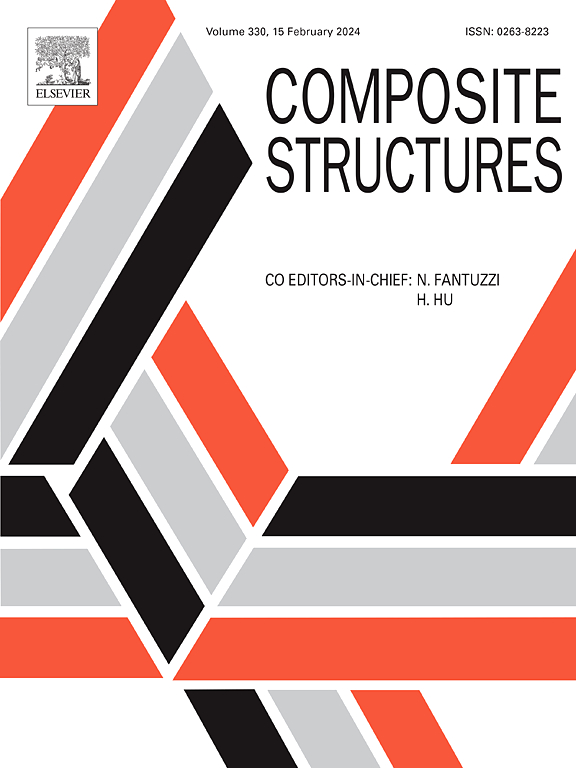Experimental and numerical analyses of the interaction between rigid non-penetrating projectiles, soft and hard tissue simulants and composite ballistic protection
IF 6.3
2区 材料科学
Q1 MATERIALS SCIENCE, COMPOSITES
引用次数: 0
Abstract
The study of ballistic personal protections often only focuses on the mechanical response and ballistic limits of the armor considered. However, understanding the armor-carrier interaction under dynamic conditions remains underexplored. This research analyzes non-penetrating ballistic impacts on gelatin samples involving multi-ply composite ballistic protection panels, focusing on biomechanical damage.
For this purpose, ballistic gelatin is presented as a reliable soft tissue simulant and thoroughly examined under non-penetrating ballistic impact conditions. The methodology includes two experimental approaches: (1) low-velocity impact tests using rigid projectiles to isolate gelatin’s mechanical behavior and (2) high-velocity impact tests with steel spherical projectiles, involving additionally ballistic protection panels and a simplified bone surrogate as a hard tissue simulant.
Due to the complexity of experimentally assessing the dynamic interaction between soft and hard tissue simulants, protection, and projectiles, an explicit finite element model has been developed. These simulations incorporate different damage models in composite protection and bone surrogate to accurately replicate the experimental tests. In addition, a proposed visco-hyperelastic constitutive model for ballistic gelatin is validated, generating a powerful predictive tool for evaluating ballistic protection and biomechanical damage.
This work provides a comprehensive study of the behind armor blunt trauma and introduces an experimental methodology to quantify the mechanical response of ballistic gelatin and hard tissue simulants under non-penetrating ballistic impacts. It addresses a key gap in modeling soft tissue simulants under high-energy conditions and validates the corresponding visco-hyperelastic constitutive model. Findings highlight the importance of considering hard tissue effects when evaluating composite protection performance, which has not been previously addressed in literature. This work proposes an alternative evaluation framework to the assessment of advanced armor and biomechanical phenomena estimation. We further provide a deeper biomechanical insight in comparison with existing standards, bridging the gap between multi-layered composite protection and the human biomechanical response.
刚性非穿透弹丸、软硬组织模拟物与复合弹道防护相互作用的实验与数值分析
对弹道防护的研究往往只关注所考虑的装甲的力学响应和弹道极限。然而,在动态条件下,对装甲-载体相互作用的理解仍未得到充分探索。本研究分析了含多层复合防弹防护板的明胶样品的非穿透性弹道冲击,重点研究了生物力学损伤。为此,弹道明胶被认为是一种可靠的软组织模拟物,并在非穿透性弹道冲击条件下进行了彻底的检查。该方法包括两种实验方法:(1)使用刚性弹丸进行低速冲击试验,以分离明胶的力学行为;(2)使用钢制球形弹丸进行高速冲击试验,包括额外的弹道保护板和简化的骨替代物作为硬组织模拟物。由于实验评估软硬组织模拟物、防护物和弹丸之间动态相互作用的复杂性,一种显式有限元模型已经被开发出来。这些模拟结合了复合材料保护和骨替代物中不同的损伤模型,以准确地复制实验测试。此外,还验证了所提出的弹道明胶粘弹性本构模型,为评估弹道防护和生物力学损伤提供了强大的预测工具。这项工作提供了装甲后钝性创伤的全面研究,并介绍了一种实验方法来量化弹道明胶和硬组织模拟物在非穿透性弹道冲击下的力学反应。它解决了在高能条件下软组织模拟建模的关键空白,并验证了相应的粘-超弹性本构模型。研究结果强调了在评估复合材料保护性能时考虑硬组织效应的重要性,这在以前的文献中没有得到解决。这项工作提出了一种替代评估框架,以评估先进装甲和生物力学现象的估计。与现有标准相比,我们进一步提供了更深入的生物力学见解,弥合了多层复合材料保护与人体生物力学反应之间的差距。
本文章由计算机程序翻译,如有差异,请以英文原文为准。
求助全文
约1分钟内获得全文
求助全文
来源期刊

Composite Structures
工程技术-材料科学:复合
CiteScore
12.00
自引率
12.70%
发文量
1246
审稿时长
78 days
期刊介绍:
The past few decades have seen outstanding advances in the use of composite materials in structural applications. There can be little doubt that, within engineering circles, composites have revolutionised traditional design concepts and made possible an unparalleled range of new and exciting possibilities as viable materials for construction. Composite Structures, an International Journal, disseminates knowledge between users, manufacturers, designers and researchers involved in structures or structural components manufactured using composite materials.
The journal publishes papers which contribute to knowledge in the use of composite materials in engineering structures. Papers deal with design, research and development studies, experimental investigations, theoretical analysis and fabrication techniques relevant to the application of composites in load-bearing components for assemblies, ranging from individual components such as plates and shells to complete composite structures.
 求助内容:
求助内容: 应助结果提醒方式:
应助结果提醒方式:


